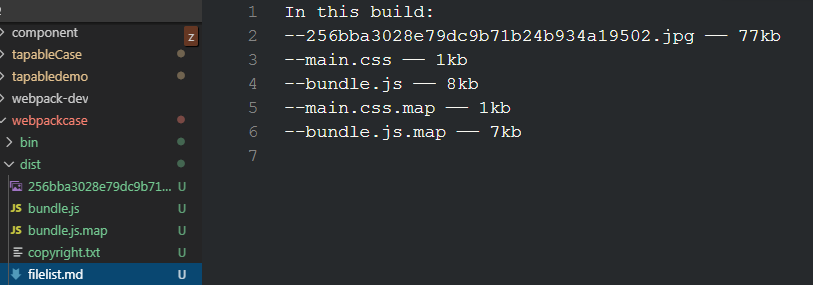案例实战之如何写一个webpack plugin
案例实战之如何写一个webpack plugin
1.写一个生成打包文件目录的file.md文件 // 生成一个目录项目目录的文件夹 class FileListPlugin { constructor(options) { this.options = options } apply(compiler) { compiler.hooks.emit.tap('fileListPlugin', (compilation) => { let assets = compilation.assets let content = 'In this build:\r\n' Object.entries(assets).forEach(([fileName, fileSize]) => { content += `--${fileName} —— ${Math.ceil(fileSize.size() / 1024)}kb\r\n` }) console.log('====content====', content) assets[this.options.filename] = { source() { return content }, size() { return content.length } } }) } } module.exports = FileListPlugin使用
const FileListPlugin = require('./plugins/fileListPlugin.js') plugins:[ new FileListPlugin({ filename: 'filelist.md' }), ]生成的结果如下
[image-20191206173728326](F:\myobject\vue2\myb

webpack 的源码compiler钩子函数是借助tapable库实现的
const { Tapable, SyncHook, SyncBailHook, AsyncParallelHook, AsyncSeriesHook } = require("tapable"); class Compiler extends Tapable { constructor(context) { super(); this.hooks = { /** @type {SyncBailHook<Compilation>} */ shouldEmit: new SyncBailHook(["compilation"]), /** @type {AsyncSeriesHook<Stats>} */ done: new AsyncSeriesHook(["stats"]), /** @type {AsyncSeriesHook<>} */ additionalPass: new AsyncSeriesHook([]), /** @type {AsyncSeriesHook<Compiler>} */ beforeRun: new AsyncSeriesHook(["compiler"]), /** @type {AsyncSeriesHook<Compiler>} */ run: new AsyncSeriesHook(["compiler"]), /** @type {AsyncSeriesHook<Compilation>} */ emit: new AsyncSeriesHook(["compilation"]), /** @type {AsyncSeriesHook<string, Buffer>} */ assetEmitted: new AsyncSeriesHook(["file", "content"]), /** @type {AsyncSeriesHook<Compilation>} */ afterEmit: new AsyncSeriesHook(["compilation"]), /** @type {SyncHook<Compilation, CompilationParams>} */ thisCompilation: new SyncHook(["compilation", "params"]), /** @type {SyncHook<Compilation, CompilationParams>} */ compilation: new SyncHook(["compilation", "params"]), /** @type {SyncHook<NormalModuleFactory>} */ normalModuleFactory: new SyncHook(["normalModuleFactory"]), /** @type {SyncHook<ContextModuleFactory>} */ contextModuleFactory: new SyncHook(["contextModulefactory"]), /** @type {AsyncSeriesHook<CompilationParams>} */ beforeCompile: new AsyncSeriesHook(["params"]), /** @type {SyncHook<CompilationParams>} */ compile: new SyncHook(["params"]), /** @type {AsyncParallelHook<Compilation>} */ make: new AsyncParallelHook(["compilation"]), /** @type {AsyncSeriesHook<Compilation>} */ afterCompile: new AsyncSeriesHook(["compilation"]), /** @type {AsyncSeriesHook<Compiler>} */ watchRun: new AsyncSeriesHook(["compiler"]), /** @type {SyncHook<Error>} */ failed: new SyncHook(["error"]), /** @type {SyncHook<string, string>} */ invalid: new SyncHook(["filename", "changeTime"]), /** @type {SyncHook} */ watchClose: new SyncHook([]), /** @type {SyncBailHook<string, string, any[]>} */ infrastructureLog: new SyncBailHook(["origin", "type", "args"]), // TODO the following hooks are weirdly located here // TODO move them for webpack 5 /** @type {SyncHook} */ environment: new SyncHook([]), /** @type {SyncHook} */ afterEnvironment: new SyncHook([]), /** @type {SyncHook<Compiler>} */ afterPlugins: new SyncHook(["compiler"]), /** @type {SyncHook<Compiler>} */ afterResolvers: new SyncHook(["compiler"]), /** @type {SyncBailHook<string, Entry>} */ entryOption: new SyncBailHook(["context", "entry"]) }; }}上面的钩子函数是在webpack解析代码的不同周期执行的
案例实战之如何写一个webpack plugin
标签:
原文地址:https://www.cnblogs.com/xinggood/p/11996934.html
,温馨提示: 本文由Jm博客推荐,转载请保留链接: https://www.jmwww.net/file/web/41413.html
- 上一篇:深入浅出网工第二个协议
- 下一篇:css代码乱码怎么解决


![[转]Node.js中package.json中^和~的区别 [转]Node.js中package.json中^和~的区别](/uploads/allimg/200519/054J34453_lit.png)